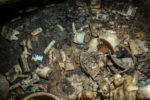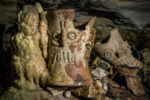 It’s actually a rediscovery, but in a very unusual turn of events, that doesn’t obviate its untouched status. Balamku, meaning Cave of the Jaguar God, is a cave system that served as a subterranean sanctuary of Chichen Itza, one the largest of the Mayan great cities and today a much-visited archaeological site on Mexico’s Yucatan Peninsula. Mexico’s National Institute of Anthropology and History (INAH) announced Monday that the underground chambers contain more than 150 artifacts from the Terminal Classic (800-1000 A.D.) in their original contexts.
It’s actually a rediscovery, but in a very unusual turn of events, that doesn’t obviate its untouched status. Balamku, meaning Cave of the Jaguar God, is a cave system that served as a subterranean sanctuary of Chichen Itza, one the largest of the Mayan great cities and today a much-visited archaeological site on Mexico’s Yucatan Peninsula. Mexico’s National Institute of Anthropology and History (INAH) announced Monday that the underground chambers contain more than 150 artifacts from the Terminal Classic (800-1000 A.D.) in their original contexts.
The cave is 1.7 miles east of Chichen Itza’s central pyramid, the Temple of Kukulcan, and was first discovered in 1966 when farmers from the neighboring town of San Felipe Nuevo came across it by accident. They reported the find to the authorities and archaeologist Victor Segovia Pinto surveyed the site. He documented the presence of numerous artifacts and then took the incredibly rare and provident step of leaving them completely alone. At the time, the practice was to remove everything that could be removed, cleaning it and either putting it on display in museums or returning them to the site that would be opened to tourists. Instead, Pinto had the entrance sealed and everyone who knew about it kept their silence.
 It worked incongruously well. In more than 50 years, nobody has plundered the Maya artifacts or even disturbed them. The sealing of the site was so effective that when researchers from the Great Maya Aquifer Project came looking for a cenote (sacred well) under Chichén Itzá, they only found the cave because they had enlisted the aid of Luis Un, who when still a teenager had been with the farmers when they stumbled on Balamku.
It worked incongruously well. In more than 50 years, nobody has plundered the Maya artifacts or even disturbed them. The sealing of the site was so effective that when researchers from the Great Maya Aquifer Project came looking for a cenote (sacred well) under Chichén Itzá, they only found the cave because they had enlisted the aid of Luis Un, who when still a teenager had been with the farmers when they stumbled on Balamku.
 This is a challenging terrain, to put it mildly. Some of the tunnels between the caves are so tight that researchers had to squeeze through on their bellies with only headlamps to light the way. They dragged themselves by their elbows through seven caves, each containing a panoply of artifacts so perfectly preserved in place that stalagmites had formed around some of them. Offerings left by the Maya in these caves include pottery vessels, plates, incense burners still containing the remains of burned materials and grinding stones.
This is a challenging terrain, to put it mildly. Some of the tunnels between the caves are so tight that researchers had to squeeze through on their bellies with only headlamps to light the way. They dragged themselves by their elbows through seven caves, each containing a panoply of artifacts so perfectly preserved in place that stalagmites had formed around some of them. Offerings left by the Maya in these caves include pottery vessels, plates, incense burners still containing the remains of burned materials and grinding stones.
To access just the first of seven ritual offering chambers identified so far within Balamku, archaeologists must crawl flat on their stomachs through hundreds of feet of tortuously narrow passages. In the original report on the cave (recently located by archaeologist and GAM investigator James Brady of California State University, Los Angeles), Segovia identified 155 artifacts, some with faces of Toltec rain god Tláloc, and others with markings of the sacred ceiba tree, a potent representation of the Maya universe. In comparison, the nearby cave of Balankanché, a ritual site excavated in 1959, contains just 70 of these objects.
“Balamku appears to be the ‘mother’ of Balankanché,” says de Anda. “I don’t want to say that quantity is more important than information, but when you see that there are many, many offerings in a cave that is also much more difficult to access, this tells us something.” […]
“For the ancient Maya, caves and cenotes [sinkoles] were considered openings to the underworld,” says Holley Moyes, a University of California, Merced expert on the archaeology and religious use of Maya caves who was not a part of the project. “They represent some of the most sacred spaces for the Maya, ones that also influenced site planning and social organization. They are fundamental, hugely important, to the Maya experience.”
But until the concept of cave archaeology began to take shape in the 1980s, archaeologists were more interested in monumental architecture and intact artifacts than they were in analyzing the residues and materials found in and around objects. When Balankanché was excavated in 1959, caves were still mapped by hand in the dark and artifacts were routinely removed from their sites, cleaned, and later put back. Of all the incense burners found in Balankanché that were filled with material that could have provided definitive evidence related to the chronology of the site, for instance, only one was ever analyzed.
The discovery of so many objects in place where they were left 1,000 years ago provides archaeologists with a unique opportunity to learn more about Maya religious practices and environmental conditions that played a pivotal role in the ritual offerings. In keeping with Pinto’s prescient vision, this has not been a traditional excavation. The team is taking a non-invasive approach to avoid altering the archaeological context.